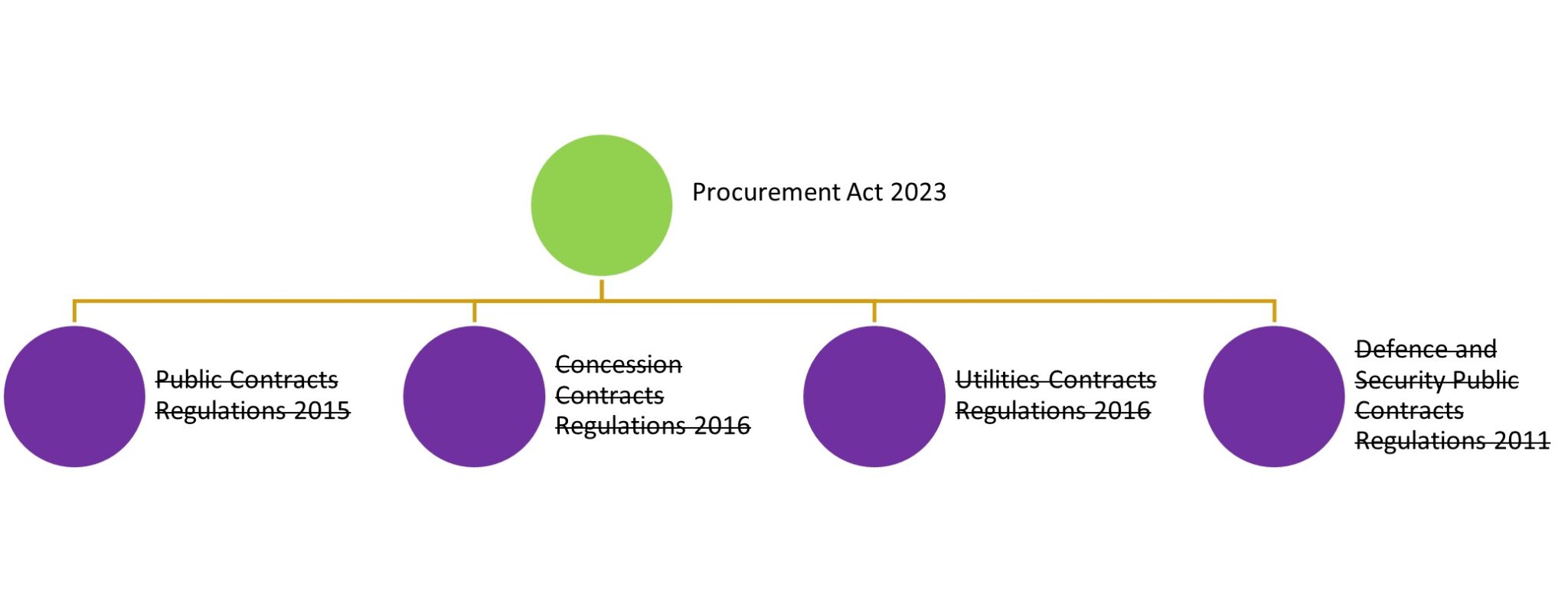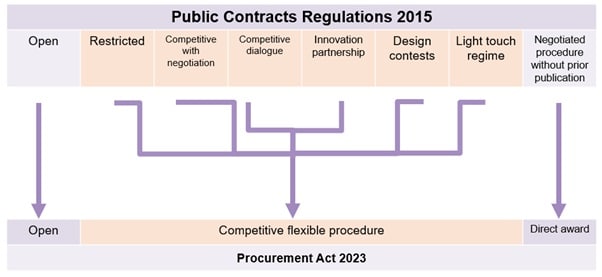What is the Procurement Act 2023?
The road to the Procurement Act 2023 was certainly long and winding and whilst the Procurement Bill received the long-awaited Royal Assent in October 2023, procurement practitioners are not home and dry yet. This article looks at what we might expect to see in the near future.
What next?
Whilst there is no current concrete date for the Act coming into force, the current planned ‘go live’ date for the new Act is October 2024. The government have confirmed that they will issue a six month notice which, if all goes to plan, will be issued in April 2024.
In short, the idea is that the Procurement Act will repeal the previous four sets of legislation and create a one stop procurement shop as follows:

Whilst the Act was sold as a “one stop shop”, the provisions of the Act rely heavily on being supplemented by additional secondary legislation to provide further meat on the bones of the Act itself. As such, secondary legislation in the form of regulations will support and fill the gaps of the Procurement Act. There were ongoing consultations to consider the regulations in the summer of 2023.
What will change?
Undertaking a procurement
Under the Public Contracts Regulations 2015 there are several prescriptive award procedures that a contracting authority could utilise. The Procurement Act reduces these down to 3 tendering procedures: the open procedure (which largely remains unchanged), the new competitive flexible procedure and direct award:

Whilst on the face of it this looks like a big change, in truth it allows contracting authorities to continue doing what they are doing, using the same procedures whilst giving some flexibility to design their own procedures subject to complying with the other requirements of the Act. Therefore, we wouldn’t suggest ripping up any template documents, policies and procedures just yet!
It is the Cabinet Office’s intention to publish model procedures and supporting documentation, so watch this space.
Authorities procuring contracts for certain social, health and education services will also be able to design their own procurement procedures that are more appropriate for those services. These can be procured as ‘Light Touch Contracts’.
The Act also introduces new rules governing circumstances where it may be necessary to award a contract without a competition including the award of contracts to protect life and public order.
Objectives, not principles
Whilst the current regulations set out principles that contracting authorities must comply with (including equal treatment, non-discrimination, transparency and proportionality), the Act sets out principles that contracting authority must “have regard” to when undertaking covered procurements. These principles include delivering value for money, maximising public benefit, sharing information for the purpose of allowing suppliers and others to understand the authority’s procurement policies and decisions and acting, and being seen to act, with integrity. Contracting authorities will also need to have regard to the relevant National Procurement Policy Statement.
“Having regard” to the objectives is a change from the use of “shall” in relation to the current principles. Whilst the Act does not expand on the extent to which contracting authorities will have to have regard to the objectives, this is a familiar concept to public authorities.
Transparency
Eagle eyed readers will note that the principle of transparency under the current regulations has not transitioned into an objective under the new Act. In fact, except for the term “transparency notice” – relating to a notice to be published following a direct award – the word transparency is not expressly stated within the Act.
However, this does not mean that contracting authorities need not act in a transparent manner when undertaking procurements pursuant to the new Act. In fact, the concept of transparency permeates throughout the Act and throughout the life of the procurement cycle through an expansion of notice requirements that contracting authorities will need to publish. There are up to 17 notices that contracting authorities may need to publish at differing times – including new notices such as pipelines notices, procurement termination notices, contract performance notices and contract termination notices.
Healthcare Contracts
Perhaps one of the biggest changes to be introduced is the new regime for the commissioning of certain healthcare services, the Provider Selection Regime (“PSR”) which came into force on 1 January 2024.
This doesn’t mean that Healthcare Providers don’t need to worry about the Procurement Act as it will still apply to NHS procurement of goods, other types of services and works which are not subject to the PSR.
You can read our article on the PSR here.
Debarment
Another significant change is the introduction of a single, public debarment list which will be centrally managed and published by the Government. The list will comprise of both excluded and excludable suppliers. An excluded supplier on the Debarment List will be barred from bidding for public contracts for a specified period and an excludable supplier may find any tender submitted being disregarded by a contracting authority.
The purpose of the Debarment List is to help prevent contracts being awarded to unsuitable suppliers and reduce the due diligence burden on contracting authorities in this regard, with the overall aim of improving supplier performance.
It will also mean that contracting authorities will need to ensure they review this list to ascertain whether any bidders are on it.
Challenging a Procurement
Limitation and Standstill
Under the Procurement Act proceedings can still be brought by suppliers that have either suffered loss or risk suffering loss as a result of an alleged breach. The time limit to bring a challenge is unchanged and remains 30 days from the date of knowledge of the breach.
There are some changes to the way decisions are to be communicated to the bidder. Under the competitive procedure, an assessment summary will be required before award together with the contract award notice. The draft Procurement (Transparency) Regulations state that such an assessment summary will not only need to provide a summary of how that tenderer scored against the award criterion (including detailed reasons), but also why they were not given the score immediately above for each criterion. Contracting authorities will also need to provide that same information about the winning bidder(s) to unsuccessful bidders. Contracting authorities will, however, welcome the fact that the need to provide the relative advantages and characteristics of the winning bidder has been dispensed with.
There is a change to the current standstill period. Under the new law the standstill period will be eight working days (previously 10 days) beginning on day of publication of the contract award notice. Whether this is a significant change in practice is questionable as the current period of 10 calendar days essentially reflects the period of eight working days, the main difference being that bank holidays and weekends will now be excluded from calculating the standstill period.
Automatic Suspension
Under the Act, the automatic suspension will only apply if court proceedings are commenced and notified during the standstill period. If the claim is started or notified after standstill has expired the contracting authority may proceed to execute the contract notwithstanding any challenge. This will work to reduce the limitation period for Claimants looking for more than damages.
The Court can still lift the suspension upon application but and will be required to consider the following when making its determination:
- the public interest in, among other things—(i) upholding the principle that public contracts should be awarded, and contracts should be modified, in accordance with the law and (ii) avoiding delay in the supply of the goods, services or works provided for in the contract or modification;
- the interests of suppliers, including whether damages are an adequate remedy for the claimant;
- any other matters that the court considers appropriate.
Remedies
The remedies available in the event of a challenge remain substantively the same as under the PCR 2015. Where the challenge is brought prior to the contract being entered into, the available remedies are:
- an order setting aside the decision of the contracting authority in the procurement;
- an order requiring the contracting authority to take action(s);
- an order for the award of damages; and/or
- any other order that the court deems appropriate.
Where the challenge is brought after the contract has been entered into, the available remedies are:
- an order that the contract or modification is set aside, where a relevant ‘condition’ has been made out (retaining the remedy of ineffectiveness that is available under the PCR 2015); and
- an order reducing the term of the contract or the goods, services of works to be supplied under it;
- may, in any case, make an order for the award of damages.
The new ‘set aside conditions’ differ from the grounds of ineffectiveness under the PCR 2015 and have been expanded to cover the following circumstances:
- a failure to publish a required contract award notice;
- the entry into or modification of a contract before the end of any applicable standstill period;
- the contract is entered into or modified during a period of automatic suspension or in breach of a court order;
- if a standstill is not mandatory, where the breach only becomes apparent on publication of the contract award notice;
- in the case of a modification, the breach only became apparent on publication of a contract award notice; or
- the breach becomes apparent only after the contract has been entered into or modified.
Notably, the last circumstance appears to be a very wide ‘set aside condition’. It is easy to envisage how this could lead to claimants seeking to expand the remedies available to them from simple damages to a more desirable set-aside order.
Until these remedies are tested by the Court, it remains unclear what their practical effect will be. Unfortunately, this will be the case for some time after the implementation of the new law which will be tested through the courts.
Training Resources
The Cabinet Office has confirmed that they will provide centrally funded learning and development packages to assist contracting authorities and bidders with the new procedures, including a detailed and comprehensive package of published resources and guidance on the regulatory framework, templates, model procedures and case studies. This will include knowledge drops through short broadcast presentations, e-learning modules for commercial staff, deep dive webinars and communities of practice events.
The Cabinet Office have published a planning and preparation checklist. In addition, knowledge drops were released on 5 December 2023 and are said to be designed for contracting authorities, suppliers and SMEs and VCSEs.
Blake Morgan have procurement experts with a wealth of experience who would be happy to answer any questions regarding the upcoming changes.
Tags: NHS Wales, Procurement Act
Enjoy That? You Might Like These:
events
articles
articles

